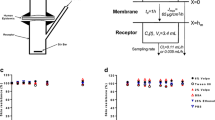Abstract
Over the years, in vitro Franz diffusion experiments have evolved into one of the most important methods for researching transdermal drug administration. Unfortunately, this type of testing often yields permeation data that suffer from poor reproducibility. Moreover, this feature frequently occurs when synthetic membranes are used as barriers, in which case biological tissue-associated variability has been removed as an artefact of total variation. The objective of the current study was to evaluate the influence of a full-validation protocol on the performance of a tailor-made array of Franz diffusion cells (GlaxoSmithKline, Harlow, UK) available in our laboratory. To this end, ibuprofen was used as a model hydrophobic drug while synthetic membranes were used as barriers. The parameters investigated included Franz cell dimensions, stirring conditions, membrane type, membrane treatment, temperature regulation and sampling frequency. It was determined that validation dramatically reduced derived data variability as the coefficient of variation for steady-state ibuprofen permeation from a gel formulation was reduced from 25.7% to 5.3% (n = 6). Thus, validation and refinement of the protocol combined with improved operator training can greatly enhance reproducibility in Franz cell experimentation.





Similar content being viewed by others
REFERENCES
Franz TJ. Percutaneous absorption. On the relevance of in vitro data. J Invest Dermatol. 1975;64:190–5.
Franz T. The finite dose technique as a valid in vitro model for the study of percutaneous absorption. Curr Probl Dermatol. 1978;7:58–68.
Farinha A, Toscano C, Campos R, Bica A, Hadgraft J. Permeation of naproxen from saturated solutions and commercial formulations through synthetic membranes. Drug Dev Ind Pharm. 2003;29:489–94.
Shah V, Elkins J, Lam S, Skelly J. Determination of in vitro drug release from hydrocortisone creams. Int J Pharm. 1989;53:53–9.
Siewert M, Dressman J, Brown C, Shah V. FIP/AAPS guidelines to dissolution/in vitro release testing of novel/special dosage forms. AAPS PharmSci Tech. 2003;4:7.
Shah V, Elkins J, Williams R. Evaluation of the test system used for in vitro release of drugs for topical dermatological drug products. Pharm Dev Technol. 1999;4:377–85.
Wester R, Maibach H. Review: percutaneous absorption of drugs. Clin Pharmacokinet. 1992;23:253–66.
Michaels A, Chandrasekaran SK, Francis W, Meredith M. Drug permeation through human skin: theory and in vitro experimental measurement. A I Ch E J. 1975;21:985–96.
Henning A, Schaefer UF, Neumann D. Potential pitfalls in skin permeation experiments: influence of experimental factors and subsequent data evaluation. Eur J Pharm Biopharm. 2009;72:324–31.
Khan G, Frum Y, Sarheed O, Eccleston GM, Meidan VM. Assessment of drug permeability distribution in two different model skins. Int J Pharm. 2005;303:81–7.
Frum Y, Eccleston GM, Meidan VM. Evidence that drug flux through synthetic membranes is assocated with normally distributed permeability coefficients. Eur J Pharm Biopharm. 2007;67:434–9.
Chilcott R, Barai N, Beezer A, Brain S, Brown M, Bunge A, et al. Inter- and intra-laboratory variation of in vitro diffusion cell measurements: an international multi-centre study using quasi-standardised methods and materials. J Pharm Sci. 2005;94:632–8.
Diembeck W, Beck H, Benech-Kieffer F, Courtellemont P, Dupuis J, Lovell W, et al. Test guidelines for in vitro assessment of dermal absorption and percutaneous penetration of cosmetic ingredients. Food Chem Toxicol. 1999;37:191–205.
Gale E, Folkes J. The Incorporation of glycerol and lysine into the lipid fraction of staphyloccoccus aureus. Biochem J. 1965;94:390–400.
He P, Davis S, Illum L. In vitro evaluation of the mucoadhesive properties of chitosan microspheres. Int J Pharm. 1998;166:75–68.
Skelly J, Shah V, Maibach H, Guy R, Wester R, Flynn GL, et al. FDA and AAPS report of the workshop on principles and practices of in vitro percutaneous penetration studies—relevance to bioavailability and bioequivalence. Pharm Res. 1987;4:265–7.
FDA-SUPAC-SS. Guidance for Industry. SUPAC-SS non-sterile semisolid dosage forms. Scale-up and postapproval changes: chemistry, manufacturing and controls. In vitro release testing and in vivo bioequivalence documentation. 1997.
Gummer C, Hinz R, Maibach H. The skin penetration cell: a design update. Int J Pharm. 1987;40:101–4.
Rolland A, Demichelis G, Jamoule J, Shroot B. Influence of formulation, receptor fluid, and occlusion on in vitro drug release from topical dosage forms, using an automated flow-through diffusion cell. Pharm Res. 1992;9:82–8.
Diez-Sales OACW, Herraez-Dominguez M, Javaloyes C, Hadgraft J. A mechanistic investigation of the in vitro human skin permeationi enhancing effect of Azone. Int J Pharm. 1996;129:33–40.
Gallagher SLT, Carter T, Heard C. Effects of membrane type and liquid/liquid phase boundary on in vitro release of Ketoprofen from gel formulations. J Drug Target. 2003;11:373–9.
Haigh J, Smith E. The selection and use of natural and synthetic membranes for in vitro diffusion experiments. Eur J Pharm Sci. 1994;2:311–30.
Scheuplein R. The Skin as a barrier. In: Jarrett A, editor. The physiology and pathophysiology of skin. London: Academic; 1978. p. 1669–92.
Akomeah F, Nazir T, Martin G, Brown M. Effect of heat on the percutaneous absorption and skin retention of three model penetrants. Eur J Pharm Sci. 2004;21:337–45.
Author information
Authors and Affiliations
Corresponding author
Rights and permissions
About this article
Cite this article
Ng, SF., Rouse, J.J., Sanderson, F.D. et al. Validation of a Static Franz Diffusion Cell System for In Vitro Permeation Studies. AAPS PharmSciTech 11, 1432–1441 (2010). https://doi.org/10.1208/s12249-010-9522-9
Received:
Accepted:
Published:
Issue Date:
DOI: https://doi.org/10.1208/s12249-010-9522-9




